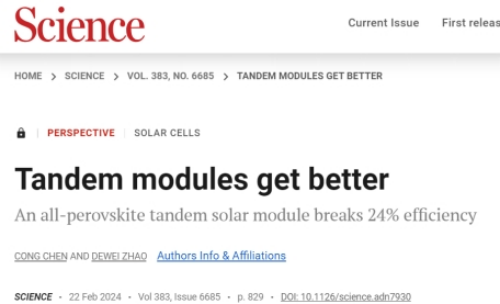
Science, an authoritative scientific journal, published in February an article titled "Tandem Modules Get Better - An All-Perovskite Tandem Solar Module Breaks 24% Efficiency" by Dewei Zhao's research team from the College of Materials Science and Engineering of Sichuan university. The first author is Cong Chen, an associate research fellow, and Professor Dewei Zhao is the corresponding author. Sichuan University is the only corresponding work unit of the article.
Perovskite (referred to as all perovskite) tandem solar modules have attracted much attention due to their simple preparation process and potential to break through the Shockley-Queisser limit of single junction solar cells. As an important component of narrow bandgap perovskite solar cells, there are still fundamental scientific and technological issues that urgently need addressing, such as uneven crystallization of large-area narrow bandgap perovskite and severe interface non radiative recombination losses. These problems seriously restrict the development of narrow bandgap and all perovskite tandem batteries and modules. Developing new preparation methods and passivation strategies to improve the crystallization uniformity of large-area narrow bandgap perovskite solar cells is of great significance for enhancing the efficiency and stability of all perovskite tandem modules.
“Solar cells play a vital role in transforming energy needs. Single-junction solar cells made of metal halide perovskite materials have shown great potential, achieving about 26% efficiency in converting sunlight into electricity. This makes them attractive for photoelectronic applications, such as lasers, light detectors, and light-emitting diodes. Breaking this efficiency limit of single-junction solar cells could be achieved with tandem solar cells, where thermalization loss is reduced and solar spectrum utilization range is broadened. Small-area all-perovskite tandem cells can reach an efficiency of >28%. However, developing large-area (∼20 cm2) allperovskite tandem modules is challenging because of difficulties incontrolling homogeneous crystallization when scaling up perovskites. On page 855 of this issue, Gaoet al. report large-area all-perovskite tandem modules that achieve >24% efficiency. The approach may offer a viable route for commercialization.” (Abstract)
This study was funded by the National Natural Science Foundation of China,the Engineering Characteristic Team Project of Sichuan University, and the special fund for basic scientific research business expenses of central universities,and so forth.
Researchers’ profile.
Dewei Zhao is a professor and doctoral student advisor of Sichuan University. He has been selected as a national level young talent, academic and technological leader in Sichuan Province, outstanding young scientific and technological talent in Sichuan Province, and the Sichuan Youth Talent Introduction Program (2019). He has also won the Green Talent Award from the German Ministry of Education and Technology and the China Scholarship Council for Outstanding Self-Funded International Students. In 2022, he was selected as a highly cited scientist of Clarivate and a highly cited scholar of Elsevier China. He also chaired national key research and development projects, intergovernmental international scientific and technological innovation cooperation projects of the national key research and development plan, etc. What’s more, he acted as a supervisor of a student team that won a gold medal of the 8th China International "Internet+" Undergraduate Innovation and Entrepreneurship Competition in 2022.
Zhao Dewei's research team has long been engaged in researching key photovoltaic materials for high-performance all-perovskite tandem solar cells and has developed a world record efficient 1cm2 all perovskite tandem cell, which has been twice included in the internationally authoritativeSolar Cell Efficiency Tables. The achievement has been selected as one of the "Top Ten Scientific Advances in Sichuan" in 2023.
Cong Chen is an associate research fellow especially engaged by the College of Materials Science and Engineering, and has been selected for the Sichuan University Double Hundred Talent Program. He has led sub projects of the National Key Research and Development Program, National Natural Science Foundation Youth Program, Sichuan Provincial Natural Science Foundation Youth Program, etc.So far, Cong Chen has published dozens of papers in Nature, Science, and Nat. Energy, Energy Environ. SCI and other SCI journals. His current research direction is broadband gap perovskite and high-efficiency perovskite tandem solar cells.
https://www.science.org/doi/10.1126/science.adn7930
